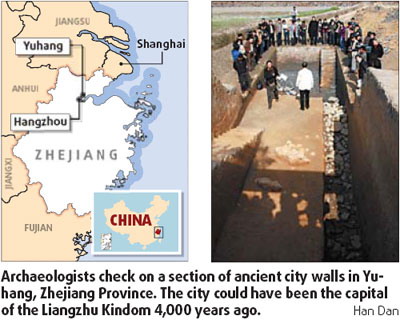Archaeologists are excited at the prospect that the remains of a 4,000-year-old city - larger than the Forbidden City - unearthed on the east coast could be the oldest kingdom in the nation's history.
The Liangzhu ancient city ruins - found in Yuhang county of Zhejiang Province - can be traced back at least 4,300 years, and cover an area of 2.9 million square meters with the city walls 4-6 meters in width.
The first discovery was made in June last year when apartment buildings were to be built in Putaoban Village of Yuhang. Archaeologists were called in because the village is part of the Neolithic Liangzhu Culture protection zone. It is centered on Yuhang and extends to present day Zhejiang, Jiangsu, Anhui and Jiangxi provinces as well as Shanghai.
The Liangzhu Culture of 5,300-4,000 years ago in east China has yielded many exquisite artworks for religious use, most notably jade artifacts.
Under a patch of rice field, archaeologists found a 40-meter-wide ancient ditch built of hardened earth, in which were large amounts of pottery shards, Liu Bin, a researcher at the Zhejiang Archaeological Institute, said over the weekend.
When archaeologists dug a deep hole on the eastern bank of the north-south ditch, they were surprised to find a large area built of hammered soil and pebbles.
Further excavations showed that the ditch was a canal outside the city, and the area to its east was the remains of part of the city wall.
The walls extended 1,500-1,700 m from east to west and 1,800-1,900 m from north to south. The city covers an area of 2.9 million sq m, 200,000 sq m more than the Forbidden City.
It is the largest Neolithic city discovered in China, said Yan Wenming, a professor at Peking University.
"The city could have been the capital of the Liangzhu Kingdom," he was quoted by the Hangzhou-based Metropolitan Express News as saying.
Historians have long speculated about the existence of such a kingdom 4 millennia ago, Liu Qingzhu, director of the Archaeological Research Institute of the Chinese Academy of Social Sciences, told China Daily Monday.
Further evidence is needed to prove the city was the capital of the kingdom, he said. "There should be remains of palaces if there used to be a political power. The essence of statehood lies in its government, not just in the walls."
If a political power existed so long ago on the east coast, it is a mystery as to how it faded away, he added.
(China Daily December 4, 2007)


